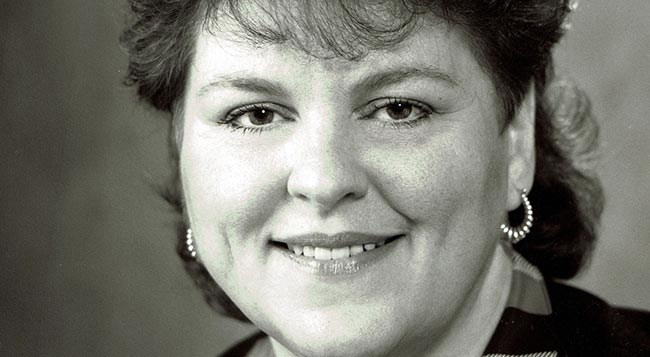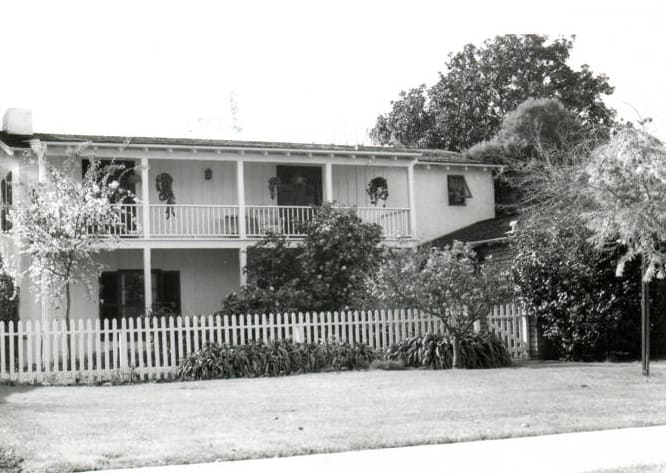Judy Wright and ‘Claremont Women 1887 – 1950’

by John Neiuber
March is Women’s History Month. The title of the column this month is the title of Judy Wright’s 2007 book, “Claremont Women, 1887 – 1950, They Created a Culture.” Wright’s contributions to the history and culture of Claremont are immeasurable.
This year marks 20 years since we moved to Claremont and many people know me through my involvement with Claremont Heritage, which is where I met Judy Wright. When I became involved in Heritage, Ginger Elliott was the executive director and Wright was on the board. When I met her, I could tell she was a force of nature, but it was only over time that I grew to understand who she was and what she had accomplished. It was a year after I joined the board that Judy published “Claremont Women.”

Portrait of Judy Wright when she served as mayor of Claremont from 1986 to 1989. Photo/courtesy of Claremont Heritage
Most small towns find themselves fortunate if there is a book about the history of their city, let alone two. Wright wrote “Claremont: A Pictorial History” in 1980. A second edition followed in 1999. These two books are pretty much the starting point when I do research for this column. If the information I am looking for is not in the pages of one of these books, the bibliography will point me in the right direction without fail. It is also the reason I have a growing library of out-of-print books written about and by Claremont founders and historic figures.
Wright, who died in 2012, was, as her husband Colin said of her, “Friendly and outgoing, tenacious without an edge and never took no for an answer.” In addition to being an author and the town’s historian, she was the coordinator of the City of Claremont’s Historic Resources Inventory, staffed the Claremont Historic Resources Center from 1979 to 1984, headed the historic preservation consulting firm, AEGIS, was a past-president of the Sycamore Elementary School PFA and the League of Women Voters, served as a planning commissioner, City Council member and mayor, was a board member of the California Preservation Foundation, was a founding board member, vice-president, and president of Foothill Transit, served as a board member and president of the League of California Cities, was a founding board of member of the Southern California Regional Rail Authority (which operates Metrolink), was a board member of Mount San Antonio Gardens, served on the board and as president of Claremont Heritage and wrote the column, “A Sense of History,” for this newspaper from 1980 to 1984 and 1997 to 2012.
We often hear the term “renaissance” to describe accomplished men. Judy was a renaissance woman, for she was certainly a woman of many talents and areas of knowledge. At the time of her death, she was working on “Claremont Women 1950 – 2000.”
In the preface to “Claremont Women 1887 – 1950,” Judy writes, “When I was on the Claremont Planning Commission and City Council, many people would ask me, ‘Aren’t we fortunate to have so many women, in policy making positions and on the staff?’ I would respond that fortune has nothing to do with it. In fact, women in public life in Claremont did not emerge in the latter part of the 20th century. There have been active, effective women in Claremont since its establishment.”

The Wright’s Monterey style home on 10th Street in Claremont. Photo/courtesy of Claremont Heritage

Bess Garner is among those profiled in Judy Wright’s book, “Claremont Women 1887 – 1950, They Created a Culture.” Photo/courtesy of Claremont Heritage
One need only read through the book to find examples of what Judy wrote in the preface. The accomplishments of women such as Phebe Estelle Spalding, Pamela Helen Goodwin Renwick, Mabel Shaw Bridges, Sarah Hathaway Bixby Smith, Leila Valentine Ackerman, Helen Rolph Wren, Bessie Fern Adams Garner, Ruth Stella Kneeland Ordway and Rosa Garcia Torrez are not only worth reading, they are inspiring.
The participation of women in all aspects of Claremont life from the beginning is likely due to a combination of things: beginning as an academic community, because of Congregationalism that allowed full participation and education of women, and because of the New England governance of the town meeting where everyone over the age of 21, men and women, could speak and vote.
Judy often said men built the colleges but women built the town. This is embodied in this statement about her book, “My premise is that early women in Claremont created a culture that includes community service, commitment, and involvement in governmental and commercial affairs, as well as support for education, arts, and the community aesthetic. Many who came afterward just took up where others left off, and they continue the culture-building today.”
Perhaps it is time we attempted to pick up where Judy Wright left off and finish that second volume. There as so many women I know personally who have contributed to our culture whose stories need to be recorded for future generations.
“Claremont Women 1887 – 1950” is available at claremontheritage.org.









0 Comments